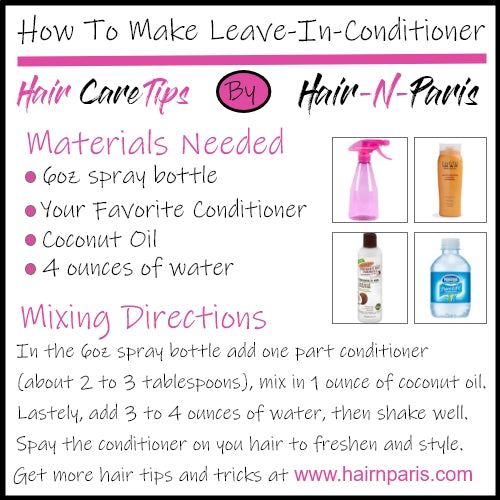The most important product that I use on my hair, as well as my sew-in, is leave-in conditioner. There are so many reasons for using leave-in conditioners that benefits the health of your hair. Leave-in conditioner, it's great for detangling hair and it continues to condition the hair after applying to your hair. Leave-in conditioner is great for refreshing your sew-in between washes and it's an awesome form of moisture, which keeps the hair smooth and smelling nice. It also contains protein to strengthen the hair which is extremely important for hair growth. I can go on FOREVER listing why leave-in conditioner should be your BFF. BUT…. I would rather teach you how to make it so you save a few bucks. The best leave-in conditioner is DIY, do it yourself. Since buying conditioner is something I do on a regular basis to go along with my shampoo. Why not just make the leave-in conditioner and save money? I have three daughters and I go through leave-in conditioner like crazy because it is also the number one product that I apply to my girl's hair as well as my own. My husband even uses the leave-in conditioner on his beard, which leaves it smelling amazing. So since I go through a bottle of leave-in conditioner five times faster than the next person, I decided to learn how to make my own leave-in conditioner. Plus I can control the ingredients that I add to make my leave-in conditioner which makes it more natural and safer for my family. It is always best to know exactly what is in the products you are using, so that is another reason I love this method.
First, take some time to think about, what your hair needs and add the ingredient that helps with that issue to your leave in conditioner. Try not to go overboard with the ingredients that you add, just to keep things simple starting out. Do some research to become aware of what mineral help with different side effects before you begin your mixture. Once you get a feel for making the product and your comfortable you can start going more in-depth with what you add. To give an example, if you deal with dry hair or itchy scalp add a little liquid based oil to your mixture of ingredients, you could even add lemon juice that will help lighten the hair. However, for this blog, we will only use basic ingredients to make our DIY leave-in conditioner.
Basic Materials You Will Need For Making DIY Leave-In Conditioner
- 6oz Spray Bottle
- Distilled Bottled Water
- Your Favorit Conditioner
- Coconut oil (liquid or melted)
Using your spray bottle mix about 2 to 3 tablespoons of your favorite conditioner. Next, add about 3 ounces of distilled water, this step is because you want to dilute the conditioner so that you no longer need to rise your hair. This method is what makes your regular rinse out conditioner a leave-in conditioner.
Now, add about 1 ounce of coconut oil, which helps with faster hair growth and dryness. I use coconut oil because it is a natural way to help your hair grow thicker, longer, and faster. The essential fatty acids and vitamins naturally found in coconut oil nourish the scalp and help to remove build-up. I also add Vitamin E because it is an antioxidant that helps repair and build tissue. This step is completely optional so I didn't include Vitamin E as part of the materials needed, which is something that is added to my leave-in conditioner mixture. Applying vitamin E will help repair damage and encourage hair growth, as well as apply shine. Make sure to shake the ingredients well so they mix together.
Now that you have your conditioner all mix and ready, apply to your natural hair as well as your sew-in bundles. Remember if your detangling your hair, spray on the leave-in conditioner and begin to detangle starting at the end of your hair. If you have questions please comment below. You may also read more hair tips by visiting my blog located at https://hairnparis.com/blogs/news. Thank you for taking the time to read and I hope you enjoy your homemade leave-in conditioner as much as I do.










